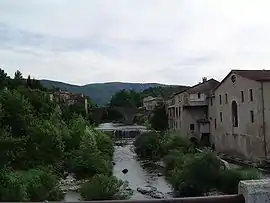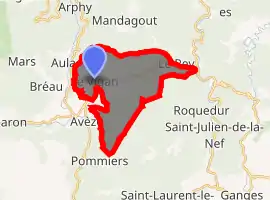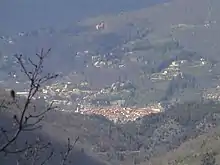Le Vigan, Gard
Le Vigan (French pronunciation: [lə viɡɑ̃] (![]() listen); Occitan: Lo Vigan) is a commune in the Gard department in southern France. It is a sub-prefecture of the department.
listen); Occitan: Lo Vigan) is a commune in the Gard department in southern France. It is a sub-prefecture of the department.
Le Vigan is supposed to occupy the site of the old Gallo-Roman town of Vindomagus. The name implies that a Celtic population was settled there. "Magh" signifies meadow or plain, and "vindo" is the Latin form given to the word we find in so many places to signify open country, wind-swept, surt-scorched, rambled over by sheep,... No descriptive appellation could better suit Le Vigan.
Le Vigan | |
|---|---|
Subprefecture and commune | |
 Le Vigan and the Arre River | |
Location of Le Vigan 
| |
 Le Vigan  Le Vigan | |
| Coordinates: 43°59′35″N 3°36′22″E | |
| Country | France |
| Region | Occitanie |
| Department | Gard |
| Arrondissement | Le Vigan |
| Canton | Le Vigan |
| Intercommunality | Pays Viganais |
| Government | |
| • Mayor (2020–2026) | Sylvie Arnal |
| Area 1 | 17.24 km2 (6.66 sq mi) |
| Population (2017-01-01)[1] | 3,820 |
| • Density | 220/km2 (570/sq mi) |
| Time zone | UTC+01:00 (CET) |
| • Summer (DST) | UTC+02:00 (CEST) |
| INSEE/Postal code | 30350 /30120 |
| Elevation | 184–640 m (604–2,100 ft) (avg. 231 m or 758 ft) |
| 1 French Land Register data, which excludes lakes, ponds, glaciers > 1 km2 (0.386 sq mi or 247 acres) and river estuaries. | |
Geography

Le Vigan is located at the south of the Massif Central and near the Mont Aigoual, in the Arre valley. The town is on the southern edge of the Cévennes National Park and is the most populous town within the park.[4]
History
On a river at the southern edge of the Massif Central, Le Vigan is situated on a natural boundaryline. In the 2nd-3rd centuries BCE, it was situated between the territories occupied by the Volcae Arecomici, the Averni, and the Gabali tribes. In 121 BCE the Romans gained control of much of southern France including the area around Le Vigan. The Volcae Arecomici voluntarily surrendered their territory,[5] and the Arverni gave up much territory in a treaty that nevertheless preserve their independence. Under Roman control, Le Vigan was part of the Roman "Provincia," (hence Provence) called Gallia Narbonensis. The Visigoths took control of the western half of Gallia Narbonensis in 462 CE, a part known as Septimania which included Le Vigan, and they retained control despite attempts in 586 and 589 by the Frankish (Merovingian) King Guntram to conquer the area from the north. In 587 the region came under Catholic rule with the conversion of the Visigoth king Reccared I. In 719, the Moor Al-Samh conquered Septimania and the Franks struggled to take it back over the next several decades. By 780, Charlemagne had conquered the entire territory. Le Vigan is on the site of an ancient Roman town which may be "Vindomagus",[6][2]:238[3] but it is not certain.[7]:851 There is a spring called "la source d'Isis," which has provided water to the city since at least 1069[8] and which was named in honor of the Roman goddess. The town was destroyed during the Moorish invasion of Provence.[2]:238[3][9]:110
Population
|
|
Economy
As with many towns in the Cévennes, there were many textile industries there in the past. Several quarries south of town above Montdardier were formerly important sources of lithographic limestone. Stone from these quarries earned an honorable mention in the Great Exhibition of 1851.[10]:28[11]
Le Vigan is a tourist destination during summer time.
Personalities
- Chevalier d'Assas (1733–1760) - A captain of the Régiment d'Auvergne famous for an account of his participation in the battle of Kloster Kampen during the Seven Years' War. He is often credited with sacrificing his life to alert his regiment to the presence of the English near their camp, with the phrase "To me, Auvergne! Here is the enemy!"[12]:97–98
- Abraham Peyrenc de Moras (1684-1732) - Banker, born a commoner, rose to the nobility and died immensely wealthy. Built the Hôtel Biron in Paris which now houses the Musée Rodin.
- Pierre Triaire (1771-1799) - soldier of the French Revolution
- Caroline Proust Actress (1967-)
- Henri Quatrefages de La Roquette (1731–1824}}, Constituent
Sights
- The musée cévenol shows the life in the Cévennes during the past centuries
- The Vieux Pont is an old bridge built during the 11th century
- The old hotel Faventines called Château d'Assas from 18th century
- The Arboretum de la Foux and Arboretum de l'Hort de Dieu are mature arboretums
See also
References
- "Populations légales 2017". INSEE. Retrieved 6 January 2020.
- Baring-Gould, Sabine (1907). A book of the Cevennes. hdl:2027/yale.39002030831532.
- Baring-Gould, S. (August 28, 1907). "A book of the Cevennes". London. hdl:2027/yale.39002030831532. Cite journal requires
|journal=(help) - "most populated towns in the cevennes - Google Search". www.google.com. Retrieved August 28, 2019.
- Gaius Julius Caesar (12 December 2012). The Gallic Wars. Winged Hussar Publishing. pp. 392–. ISBN 978-1-62018-073-0.
- Dictionary of Greek and Roman Geography. Walton & Murray. 1872. pp. 1311–.
- Richard Stillwell (14 March 2017). The Princeton Encyclopedia of Classical Sites. Princeton University Press. ISBN 978-1-4008-8658-6.
- https://levigan.fr/wp-content/uploads/2017/09/Petit-journal-du-Vigan-15.pdf
- Taylor, Isaac (1865). Words and Places: Or, Etymological Illustrations of History, Ethnology, and Geography. Macmillan. p. 110.
- Commissioners for the Exhibition of 1851, Great Britain (1852). Reports by the Juries on the Subjects in the Thirty Classes Into which the Exhibition was Divided. Great Britain: Royal commission. p. 28.
- Class I, Report on Mining, Quarrying, Metallurgical Operations, and Mineral Products, Reports by the Juries on the Subjects in the Thirty Classes Into Which the Exhibition was Divided, Exhibition of the Works of Industry of All Nations, 1851, Clowes, London, 1852; page 28.
- Pajol, Général Charles Pierre Victor (1891). Les Guerres sous Louis XV. tome 5. Paris: Librairie de Firmin Didot & Frères. ISBN 9780543944320.